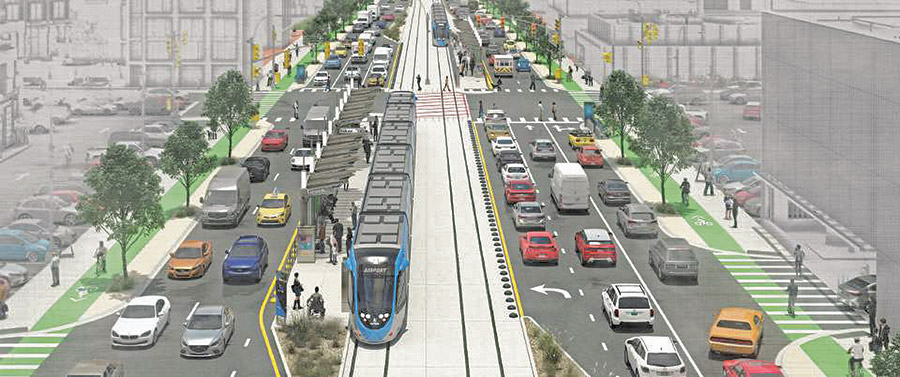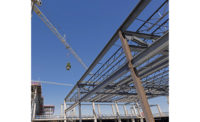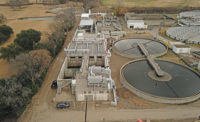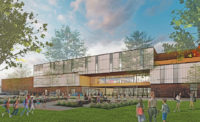Chemicals Maker Names Contractors for $8.5B Plant
Preconstruction work is underway on a project for an $8.5-billion industrial plant in Orange, Texas, that would produce polyethylene resins used for various goods including food and medicine packaging.
Owner Golden Triangle Polymers Co. LLC, a joint venture of Chevron Phillips Chemical Co. and QatarEnergy, expects to complete construction and begin production at the plant in 2026.
The owner says it expects about 4,500 construction jobs will be involved with the project. CPChem is acting as construction manager for the job and has selected a team of contractors for different pieces of the project.
PCL Industrial Construction Co. is building seven plant cracking furnaces, while Technip Stone & Webster Process Technology Inc. is handling engineering and procurement for the furnaces, the owner says. A joint venture of JGC America Inc. and Kiewit Energy Group Inc. is responsible for engineering, procurement and construction of additional portions of the ethane cracker.
The contracting team includes a joint venture of Zachry Industrial Inc. and DL USA Inc. for engineering, procurement and construction of polyethylene units, according to Golden Triangle Polymers.
Utilities and infrastructure are under the scope of BMZ Third Coast Partners, a joint venture of Burns & McDonnell Engineering Co. and Zachry Industrial Inc.
W.T. Byler Co. is managing heavy civil work as well as construction of a rail and storage-in-transit yard. Emerson Process Management is handling the plant’s automation.
The plans call for the facility to include a 2,080-KTA ethane cracker, which will be among the largest in the world, according to Emerson, as well as two 1,000-KTA high-density polyethylene units. CPChem will operate the plant.
The location, near Port Arthur on the Gulf Coast, was picked in part for its access to Permian Basin shale natural gas liquid reserves, the owners previously said. Ethane crackers use natural gas to produce ethylene.
CPChem and QatarEnergy announced the partnership in 2019. They are also currently building a petrochemical facility in Qatar that they say will include the largest ethane cracker in the Middle East.
By James Leggate
TxDOT Expansion of Southeast Connector Boosts Cost to $2.1B
The Texas Dept. of Transportation (TxDOT) added a 2.5-mile expansion to its Southeast Connector project that will widen the SE Loop of Interstate 820, the agency said. The expansion boosts the project’s cost from $1.6 billion to $2.1 billion, making it the costliest infrastructure project in the state’s history. TxDOT said the expansion will improve safety by updating frontage roads, sidewalks and bike lanes.
Last April, a contract was awarded to a joint venture between Kiewit Infrastructure South Co. and Austin Bridge and Road Services LP. The project brings together Interstate 20, I-820 and U.S. 287 in the southern part of Tarrant County. The completion list is long: building three major highway interchanges, increasing the number of road lanes from six to eight and adding frontage roads to improve entrance and exit ramps for better traffic flow and safety. Also, bicycle and pedestrian lanes are planned.
In November 2021, TxDOT awarded the design-build and maintenance contracts to South-Point Contractors, a joint venture between Kiewit Infrastructure South Co. and Austin Bridge and Road LP. Completion of that 13.5-mile project is slated for 2027.
The Southeast Connector is part of the Texas Clear Lane initiative, which aims to address the most congested chokepoints in the state by financing needed improvements. The Texas Clear Lane initiative is overseen by the Texas Transportation Commission. A portion of the funding also comes from the North Central Texas Council of Governments and Proposition 1 revenues, which are collected from oil and gas severance fees.
By Daniel Tyson
Austin Transit Partnership Unveils Design Concepts For Light Rail Expansion

The Austin Transit Partnership recently announced five design options for its $1-billion light rail expansion project.
Rendering courtesy Austin Transit Partnership
The Austin Transit Partnership unveiled five scaled-down design concepts for its light rail expansion on March 22. The $1-billion project does not go as far as the city had originally planned. All five plans connect some parts of Austin both north and south of Lady Bird Johnson Lake, but only one of the designs reaches the airport.
The light rail expansion is part of the voter-approved Project Connect, which also includes additional bus routes across Texas’ capital city.
“The best way to get to the full vision is to start with an initial core system, and we believe these five options get Austin down that path,” Greg Canally, ATP executive director, told media outlets.
“The best way to get to the full vision is to start with an initial core system, and we believe these five options get Austin down that path.”
—Greg Canally, Executive Director, Austin Transit Partnership
Project costs jumped nearly 50% since last year, he said, curtailing the city’s original plan for the Orange Line connecting north and south Austin while the Blue line headed to the airport. Each plan is estimated at around $6 billion, with capacity for 5,000 riders daily.
The first concept is an on-street 9.6- to 9.8-mile stretch with 13 to 14 light rail stations. It would require significant utility relocation but would allow for future system north, east and south expansions and additional platforms.
The second concept also envisions a 9.6- to 9.8-mile line with 13 to 14 station stops. This plan would have north and south options and would require significant utility relocation. Future expansion would require grade separation.
The third option is also an on-street rail going to the Austin-Bergstrom International Airport. The design calls for a 10.1-mile expansion with 13 light rail stations. This option would allow a “one-seat ride” connection between the airport and downtown Austin. It allows for possible north and east coverage. However, it requires significant utility relocation and impacts park property and a floodplain.
The fourth option is 8.7 miles of partially elevated travel with 13 rail stops. It has north, east and south coverage. The elevated design would reduce utility, parkland, floodplains and right-of-way issues.
The final design is a 6.6-mile underground option that would provide the benefits of an underground station and shorter travel times and lessen parkland and floodplain issues.
In early March, the ATP announced an international partnership of teams led by HKS, UNStudio and Gehl to design a system-wide architecture and urban design for the light rail program.
A statement by HKS said the team “will design a technologically advanced, human-centric transit experience true to Austin’s culture and landscape.





Post a comment to this article
Report Abusive Comment